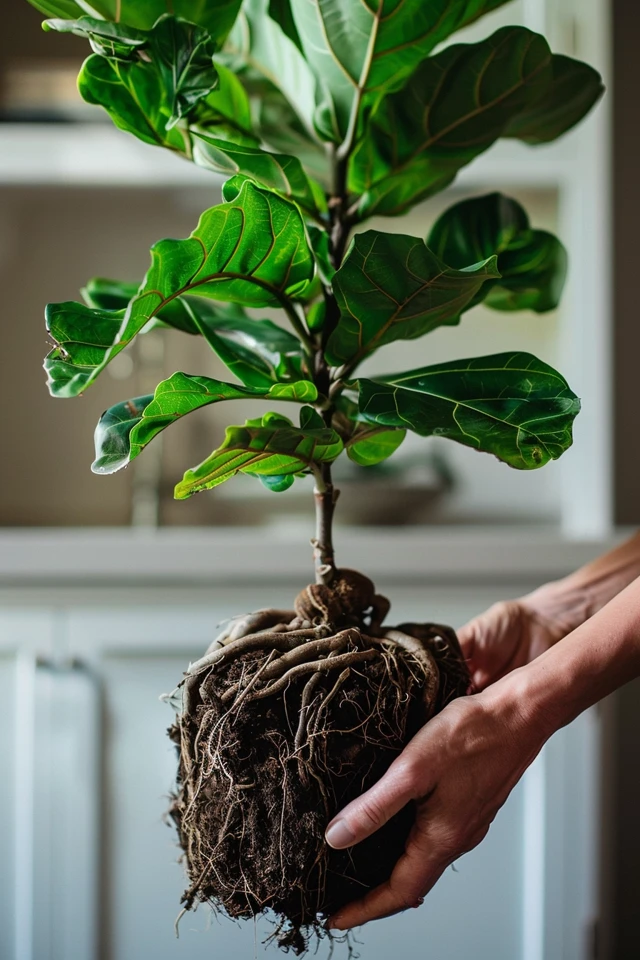Hi, I’m here to share some valuable tips on how to repot a fiddle leaf fig with root rot, and provide essential plant health advice to ensure your fiddle leaf fig thrives. Root rot can be a significant issue for these popular houseplants, but with the right treatment, you can help your fiddle leaf fig recover and flourish.
If you notice brown spots on the leaves or the leaves dropping, it could be a sign of root rot caused by over-watering. This condition suffocates the roots due to excessive moisture in the soil. To save your fiddle leaf fig, it’s important to repot it using the following steps:
Key Takeaways:
- Recognize the signs of root rot in your fiddle leaf fig, such as brown spots on leaves and dropping leaves.
- To repot your plant, carefully remove it from the pot and inspect the roots for brown and mushy textures.
- Trim any diseased roots and repot in fresh, well-draining soil.
- Avoid over-watering your fiddle leaf fig and ensure proper drainage to prevent future root rot.
- Continue caring for your fiddle leaf fig by providing adequate light, watering when the top inch of soil is dry, and removing damaged leaves.

How To Diagnose and Prevent Root Rot in Fiddle Leaf Fig Plants
When it comes to the health of your fiddle leaf fig plant, one of the most common and damaging issues is root rot. Diagnosing root rot early on is crucial to saving your plant and preventing further damage. Here are some essential steps to help you identify and address root rot in your fiddle leaf fig:
- Look for signs of root rot: Check for brown and mushy roots, as healthy roots should be white and firm. Additionally, wet and soaked soil, along with a foul smell, are telltale signs of root rot.
- Remove the plant from its pot: Gently take your fiddle leaf fig out of its pot, being careful not to damage the roots further.
- Inspect the roots: Examine the roots closely to confirm the presence of root rot. If you notice brown, slimy, and mushy roots, your plant is likely suffering from root rot.
Diagnosing root rot as early as possible allows you to take immediate action to save your fiddle leaf fig.
“Root rot can have devastating effects on fiddle leaf fig plants if left untreated. By learning how to diagnose and prevent it, you can protect the health and longevity of your beloved plant.” – PlantCarePro
To prevent root rot in fiddle leaf fig plants, it’s important to focus on proper watering and drainage:
- Water your plant appropriately: Overwatering is the leading cause of root rot, so be mindful not to water your fiddle leaf fig excessively. Allow the top inch of soil to dry out before watering again.
- Ensure proper drainage: Choose a well-draining potting soil and make sure your plant’s pot has drainage holes. Good drainage helps prevent water from pooling around the roots, reducing the risk of root rot.
- Avoid over-fertilizing: Excessive use of fertilizer can lead to salt build-up in the soil, making it harder for the roots to absorb water. Stick to a balanced fertilization schedule to maintain the health of your plant.
By following these tips and regularly checking your fiddle leaf fig for signs of root rot, you can protect your plant from this damaging condition and ensure its overall well-being.

Conclusion
Root rot can be a serious threat to the health of your fiddle leaf fig plants. However, by learning to recognize the signs and taking immediate action, you can save your precious foliage. Repotting the plant with proper drainage and soil is crucial to fostering its recovery. Remember to incorporate regular care practices such as providing the right amount of water, ensuring adequate light exposure, and removing any damaged leaves. These steps, combined with vigilant maintenance, will help prevent future occurrences of root rot and promote the vibrant health and growth of your fiddle leaf fig plants.

